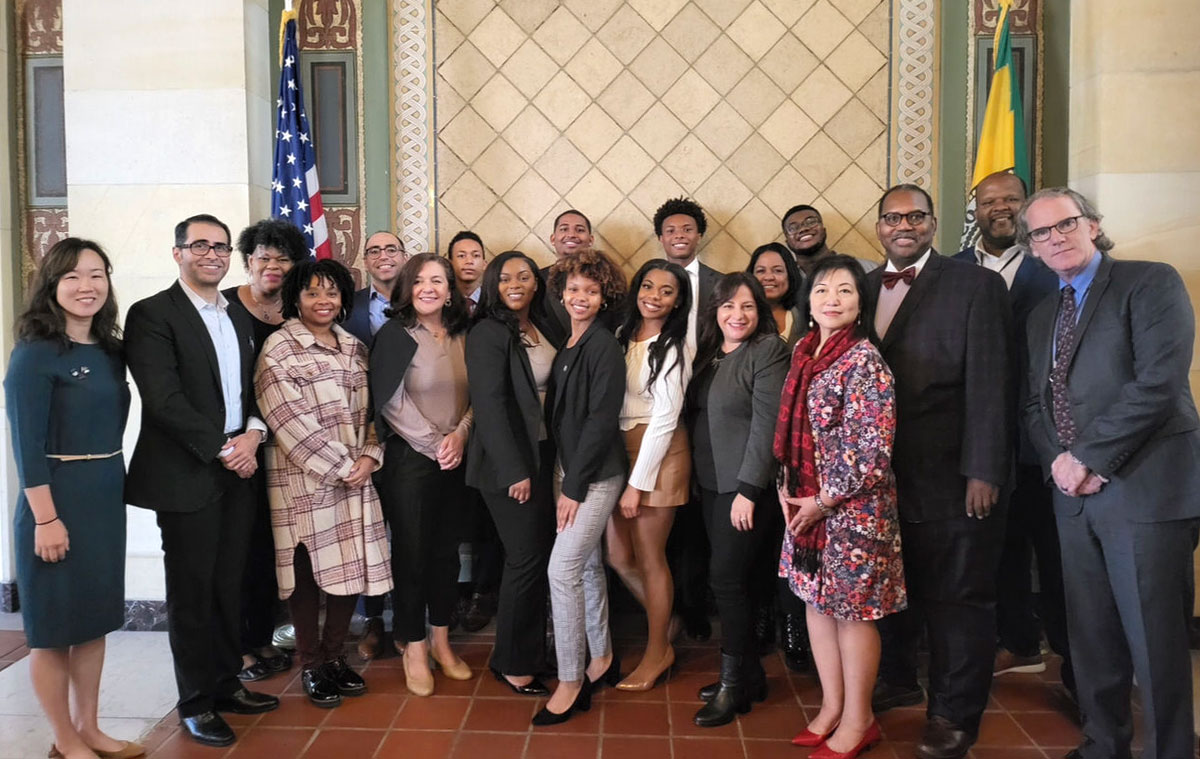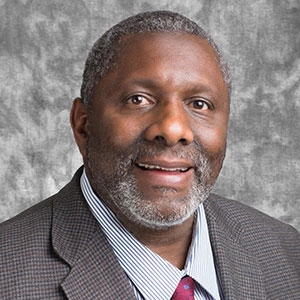
Innovation Exposition and Tech Day interns with City staff and City of LA Board of Public Works Commissioner, and President Pro Tempore Dr. Mike Davis (third from the right). Photo by the City of LA
Tough engineering challenges in the City of Los Angeles require creative thinking and a wide diversity of perspectives.
While the second largest city in the U.S. has plenty of opportunities for engineers to shine, many students at Historically Black Colleges and Universities (HBCUs) may not be aware of just how interesting and rewarding public service careers can be, nor that there are defined pathways to connect with the City of Los Angeles for future professional engineering careers.
Theodore Higgins is among several city employees and leaders aiming to change that. He is a Chief Environmental Compliance Inspector for L.A. Sanitation and Environment (LASAN) and a longtime CWEA member and past chair of the Pretreatment, Pollution Prevention, and Stormwater Committee. Theodore led the largest Pretreatment Conference on the West Coast in 2021.
“We applaud the vision and leadership of Michael and Theo and their dedication to creating career pathways into the world of water,” said Jenn Jones, Executive Director and CEO for CWEA. “Careers in water offer tremendous opportunities, including the potential for promotions into leadership roles and the opportunity to give back to our communities. It is so important that the water workforce is reflective of the Californians that we serve.”
Through the city’s HBCU Committee Innovation Exposition and Tech Day, Higgins and a slew of city and regional leaders are helping these talented students explore the city’s engineering challenges and experience how solutions are developed every day by a diverse team working together.
But solving problems isn’t the program’s only goal. City officials hope to increase the numbers of Black engineers to help solve these tough public works problems.
In fall 2022, the inaugural Innovation Exposition and Tech Day program introduced HBCU students to engineers and other professionals from different city departments and local agency partners. Students explored the daily work and cultures of engineers, gaining insight into a range of diverse backgrounds and discovering new ways that their own culture can enrich the workplace.

Michael Simpson
The Innovation Exposition and Tech Day program is the brainchild of Michael Simpson, P.E., head of LA San’s Industrial Waste Management Division, and a longtime CWEA leader, and Los Angeles Board of Public Works Commissioner Dr. Michael Davis. Karina Afework, Environmental Engineering Associate with LA Sanitation helped with planning the program.
Michael is Past-Chair of CWEA’s P3S Committee and led the organizing committee for the 2014 P3S Conference in Long Beach.
“The program emerged as a way to extend the City’s engineering college recruitment to HBCUs, which graduate a significant percentage of the country’s Black engineers and to create pathways for HBCU students to compete for entry-level career opportunities,” said Higgins, who coordinates the internship portion of the program.
Despite representing a small portion of engineering schools throughout the nation, HBCUs have made an impressive impact: they account for over 30% of all Black engineers graduating nationwide. The HBCU Committee Innovation Exposition and Tech Day project is one of several City programs focused on increasing recruitment from HBCUs as part of its greater diversity, equity and inclusion efforts.
As part of the first Innovation Exposition and Tech Day, students were invited to apply for an $800 stipend and virtual internship lasting five weeks. The program accepted 16 students from nine HBCUs: Alabama A&M University, Hampton University, Howard University, Jackson State University, Morehouse College, Morgan State University, North Carolina A&T, Prairie A&M University, and Texas Southern University.
The 16 student interns were paired up with professionals from a city department or another local agency partner. There, they worked with engineering professionals to conduct research and make recommendations on topics as varied as how to install traffic roundabouts instead of traffic lights or stop signs, finding ways to recycle or reuse plastic shade balls meant to stop evaporation in Los Angeles reservoirs, and documenting development trends related to accessory dwelling units or ADUs.
After the research phase was completed, the students presented their findings and recommendations to a panel of evaluators. The top three teams were then invited to Los Angeles to present their research to the Los Angeles Board of Public Works and City Department executives.
Among them were Morehouse senior Chase Garrison and sophomore Matias Germain. The duo presented a simple, cost-effective solution for repurposing of the Los Angeles Department of Water and Power’s 96 million plastic shade balls—incorporating them into poured concrete slabs, reducing the amount of concrete needed in construction and thus cutting carbon emissions, cost and weight.
Garrison’s experience was a resounding affirmation of his chosen career path in engineering.
“There’s a recognition of the need for Black engineers,” he said. “It started to help me realize my worth to the world of engineering.”
Leading the internship portion of the program on behalf of L.A. Sanitation and Environment was a privilege for Higgins, who enjoyed supporting and mentoring the outstanding group of students. He praised their drive, creative thinking, and hard work, noting that many are already making waves as nonprofit founders, athletes and more in addition to their engineering studies.
“It was very humbling to be able to give back to this next generation of leaders,” Higgins said.